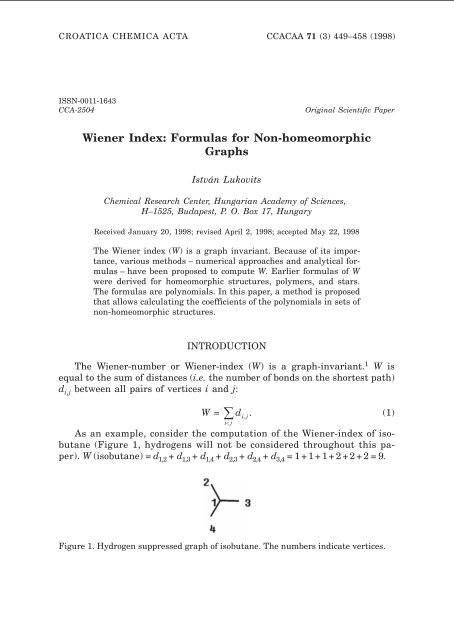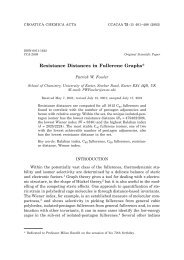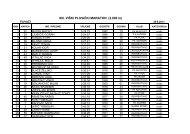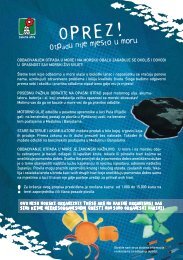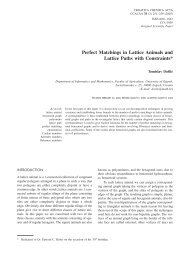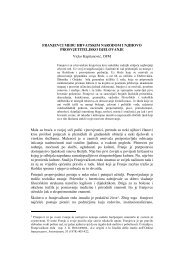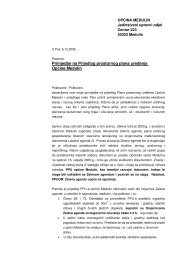Wiener Index: Formulas for Non-homeomorphic Graphs
Wiener Index: Formulas for Non-homeomorphic Graphs
Wiener Index: Formulas for Non-homeomorphic Graphs
Create successful ePaper yourself
Turn your PDF publications into a flip-book with our unique Google optimized e-Paper software.
CROATICA CHEMICA ACTA CCACAA 71 (3) 449¿458 (1998)ISSN-0011-1643CCA-2504Original Scientific Paper<strong>Wiener</strong> <strong>Index</strong>: <strong>Formulas</strong> <strong>for</strong> <strong>Non</strong>-<strong>homeomorphic</strong><strong>Graphs</strong>István LukovitsChemical Research Center, Hungarian Academy of Sciences,H–1525, Budapest, P. O. Box 17, HungaryReceived January 20, 1998; revised April 2, 1998; accepted May 22, 1998The <strong>Wiener</strong> index (W) is a graph invariant. Because of its importance,various methods – numerical approaches and analytical <strong>for</strong>mulas– have been proposed to compute W. Earlier <strong>for</strong>mulas of Wwere derived <strong>for</strong> <strong>homeomorphic</strong> structures, polymers, and stars.The <strong>for</strong>mulas are polynomials. In this paper, a method is proposedthat allows calculating the coefficients of the polynomials in sets ofnon-<strong>homeomorphic</strong> structures.INTRODUCTIONThe <strong>Wiener</strong>-number or <strong>Wiener</strong>-index (W) is a graph-invariant. 1 W isequal to the sum of distances (i.e. the number of bonds on the shortest path)d i,j between all pairs of vertices i and j:W= d ij ,. (1)ijAs an example, consider the computation of the <strong>Wiener</strong>-index of isobutane(Figure 1, hydrogens will not be considered throughout this paper).W (isobutane) = d 1,2 + d 1,3 + d 1,4 + d 2,3 + d 2,4 + d 3,4 =1+1+1+2+2+2=9.Figure 1. Hydrogen suppressed graph of isobutane. The numbers indicate vertices.
450 I. LUKOVITSW is one of the most freqnently applied graph theoretical invariants. Whas been used to explain the variation in boiling points, molar volumes, refractiveindices, heats of isomerization and heats of vaporization of alkanes. 1Later heats of <strong>for</strong>mation, atomization, isomerization, and vaporization aswell as density, critical pressure, surface tension, viscosity, melting points,partition coefficients, chromotographic retention indices, and stability ofcrystal lattices of various kinds of molecules were related 2,3 to W. Besideschemistry, the concept of the <strong>Wiener</strong> number has been used in electricalengineering 4 and mathematics. 5 Quite a few graph invariants related to Whave been proposed, too. 6In addition to Eq. (1), analytical <strong>for</strong>mulas have been proposed <strong>for</strong> W.<strong>Wiener</strong> derived a <strong>for</strong>mula <strong>for</strong> chains 1 (i.e. <strong>for</strong> acyclic structures having twoendpoints), Entringer et al. 7 and Bonchev et al. 8 proposed <strong>for</strong>mulas <strong>for</strong> simplecycles, Trinajsti} et al. obtained <strong>for</strong>mulas <strong>for</strong> polymers 9 and Gutman derived<strong>for</strong>mulas <strong>for</strong> various types of acyclic graphs. 10 A <strong>for</strong>mula was also derived<strong>for</strong> fused bicyclic structures. 11 Canfield et al. proposed a recursionmethod to obtain appropriate <strong>for</strong>mulas <strong>for</strong> any acyclic structure. 12 Each ofthese <strong>for</strong>mulas is valid <strong>for</strong> a given set of <strong>homeomorphic</strong> structures, polymersor stars. Two graphs are <strong>homeomorphic</strong> if both can be obtained from thesame graph by a sequence of subdivisions of lines. For example any two cyclesare <strong>homeomorphic</strong>, any two chains are <strong>homeomorphic</strong> and the star depictedin Figure 1 is <strong>homeomorphic</strong> with the structure depicted in Figure 2.In this paper, a method will be proposed that allows to obtain <strong>for</strong>mulas <strong>for</strong> abroader set of structures.Figure 2. Example of a »starlike« graph containing three chains. k =2,m =3,andn= 4. The branching vertex belongs to all three chains.DERIVATION OF FORMULASExpressions »vertex« and »atom«, »chemical structure« and »graph«,»bond« and »edge«, »valence« and »degree« are synonymous words used inchemistry and graph theory, respectively, and will be used interchangeablyhereafter.Consider a »starlike« graph (Figure 2) that has a single branching vertex,and three side-chains k, m, and n, where k, m and n denote both thenumber of vertices of the side chain and the side-chains themselves. A starlikegraph (Figure 2) is <strong>homeomorphic</strong> with a star which has a branching
FORMULAS FOR NON-HOMEOMORPHIC GRAPHS 451vertex of the same degree (Figure 1). The branching atom belongs to allside-chains. Example: isobutane (Figure 1) consists of three side chains, andeach side chain contains two vertices. Instead of »side-chain«, we shall usethe expression »string« to denote a chainlike subgraph starting with an endpointor a branching vertex and ending with and endpoint or a branchingvertex. An atom between these two vertices (if any) is bivalent.The <strong>Wiener</strong> index of a starlike graph containing strings k, m and n (Figure2) may be calculated by using the following <strong>for</strong>mula: 2,3W = (k 3 + m 3 + n 3 )+3(k 2 m + k 2 n + m 2 n + km 2 + kn 2 + mn 2 )––6(k 2 + m 2 + n 2 )–6(km + kn + mn) +5(k + m + n)/6. (2)For isobutane with k = m = n=2, we obtain:W = (2 3 +2 3 +2 3 ) + 3(2 2 2+2 2 2+2 2 2+22 2 +22 2 +22 2 ) – 6(2 2 +2 2 +2 2 ) – 6(22 +22 +22) + 5(2 + 2 + 2)/6 = (24 + 144 – 72 – 72 + 30)/6 = 9, thesame value that was obtained by using Eq. (1). Eq. (2) remains valid if anyof the side chains disappears, i. e. the size of the corresponding string – e.g.n – is equal to 1. Let us use Eq. (2) to obtain W <strong>for</strong> propane, then k =3,m = n = 1, and W = (3 3 +1 3 +1 3 ) + 3(3 2 1+3 2 1+1 2 1+31 2 +31 2 +11 2 ) – 6(3 2 + 1 2 + 1 2 ) – 6(31 +31 +11)+5(3+1+1)/6 = (29 + 78 – 66 – 42 + 25)/6 = 4, in accordance with thevalue that could be obtained <strong>for</strong> the (hydrogen suppressed) graph of propane.We want to derive a similar <strong>for</strong>mula <strong>for</strong> a starlike graph containing fourstrings k, m, n and o (Figure 3) and the <strong>for</strong>mula should have the following<strong>for</strong>m:W = A 4 (k 3 + m 3 + n 3 + o 3 )+B 4 (k 2 m + k 2 n + k 2 o + m 2 n + m 2 o + n 2 o ++km 2 + kn 2 + ko 2 + mn 2 + mo 2 + no 2 )+D 4 (k 2 + m 2 +n 2 + o 2 )++ E 4 (km + kn + ko + mn + mo+ no) +F 4 (k + m + n + o)/6 (3)Figure 3. Example of a »starlike« graph containing four chains. The branching vertexbelongs to all four chains, k =2,m =3,n =4,ando =5.
Gewerkschaften die Stärkung ihrer Organisationsbasis immer mehr ins Zentrumihrer Politik gerückt und waren hierdurch in der Lage, den anhaltendenMitgliederverlust deutlich zu verlangsamen oder in Teilbereichen sogar gänzlichzu stoppen. Bei den zahlreichen Organizing-Projekten spielt hierbei dieenge Verzahnung von Tarif-, Betriebs- und Organisationspolitik eine zentraleRolle Durch die Mobilisierung im Betrieb ist es in vielen Einzelfällen gelungen,die Tarifflucht von Unternehmen zu verhindern und einzelne Firmenauch neu in die Tarifbindung zu zwingen.In vielen Wirtschaftsbereichen und Branchen steht der Aufbau gewerkschaftlicherOrganisationsmacht jedoch vor großen strukturellen Schwierigkeiten,sodass die gewerkschaftliche Stärke allein auf absehbare Zeit nicht ausreichendürfte, um die Tarifbindung abzusichern. Deshalb bedarf es auch inDeutschland einer politischen Stützung des Tarifvertragssystems "von oben".Einen in jüngster Zeit wieder vermehrt genutzten Ansatz hierfür bilden dieTariftreuegesetze, durch die der Staat seine Marktmacht als öffentlicher Auftraggebernutzt, um die Einhaltung von Tarifverträgen zu stärken.AVE HAT SCHLÜSSELSTELLUNG Darüber hinaus kommt für die Re-Stabilisierung des Tarifvertragssystems der Re<strong>for</strong>m der AVE eine Schlüsselstellungzu. Als ersten Schritt bietet sich hierbei die Ausdehnung des Arbeitnehmer-Entsendegesetzes(AEntG) auf alle Branchen an. Das AEntG existiertseit Mitte der 1990er Jahre. Über lange Zeit hinweg wurde es jedoch nurfür die Baubranche und baunahe Handwerksbereiche angewendet. Erst inden letzten Jahren kamen neue Bereiche wie die Gebäudereinigung, dasWach- und Sicherheitsgewerbe oder der Pflegesektor hinzu. Mittlerweileexstieren in neun Branchen allgemeinverbindliche Löhne auf der Basis desAEntG. Wobei zumeist lediglich ein unterster Lohn festgelegt wird; in Ausnahmefällengibt es einen zweiten Lohn für Fachkräfte. Ein wichtiger Re<strong>for</strong>mschrittläge darin, dass im Rahmen des AEntG zukünftig nicht nur dieuntersten Lohngruppen als Mindestlöhne, sondern möglichst die komplettenLohntabellen allgemeinverbindlich erklärt werden.Schließlich wäre auch darüber zu diskutieren, ob die Veto-Position des Tarifausschusses(die faktisch eine Veto-Position der Arbeitgeberseite ist) nochzeitgemäß ist. Dazu kommt das relativ hohe Quorum: Es besagt, dass einTarifvertrag nur dann für allgemeinverbindlich erklärt werden kann, wenn dietarifgebundenen Unternehmen mehr als 50 Prozent der Beschäftigten einerBranche repräsentieren. Im Hinblick auf das im Tarifvertragsgesetz ge<strong>for</strong>derte"öffentliche Interesse" sollten zukünftig auch Tarifverträge mit niedrigererTarifbindung allgemein verbindlich erklärt werden dürfen.Wie auch immer eine Re<strong>for</strong>m der AVE im Einzelnen aussehen wird: Ohnedass auch in Deutschland wie in vielen anderen europäischen Ländern wiederdeutlich mehr Tarifverträge allgemeinverbindlich erklärt werden, dürfteeine Trendumkehr oder gar substanzielle Steigerung der Tarifbindung kaumzu erreichen sein.Veröffentlicht im Magazin Mitbestimmung Ausgabe 07+08/2011Mehr In<strong>for</strong>mationenReinhard Bispinck (Hrsg.): Zwischen Beschäftigungswunder und Lohndumping.Tarifpolitik in und nach der Krise. VSA-Verlag, Hamburg, 201, 150 Seiten.4
FORMULAS FOR NON-HOMEOMORPHIC GRAPHS 4552B" 22 +2E" 22 + F' =F 3 = 5 (27)B" 22 = B 3 =32C 22 + E" 22 = E 3 = –6 (28)B + 22 = B 3 = 3 (29)2A 22 +2B 22 +2D 22 + E 22 +2F 22 + G 22 = 0. (30)By choosing k = o = m = n = 1, a simple chain results, and the chain <strong>for</strong>muladoes not contain second and zero order (constant) terms (see Appendix, Eq.(A1)), whereas the coefficient of x (the first order term) is equal to –1.4B + 22+ D' = 0 (31)4B" 22 +4C 22 +4E" 22 + F' = –1 (32)4A 22 +4B 22 +8B' 22 +4D 22 +2E 22 +4F 22 + G 22 = 0 (33)Finally, by choosing o = n = 1 again a simple chain results, consisting ofthree parts (see Appendix, Eq. (A4)). Comparison of coefficients k 2 , k, kx andthe constant yields the following equations, respectively:B 22 + B' 22 + D 22 = –6 (34)B 22 + B' 22 + E 22 + E' 22 + F 22 = 11 (35)C 22 + E" 22 = – 12 (36)2A 22 +2B' 22 +2D 22 + E' 22 +2F 22 + G 22 = –6 . (37)Solution of the system of linear equations (20)–(37) yields the coefficientsof Eq. (19). Numerical values of the coefficients are listed in Table I.A similar procedure can be used to calculate the coefficients <strong>for</strong> a graphcontaining two branching atoms of degree four (Figure 6), and in general <strong>for</strong>any graph containing two branching atoms with a degree of k + 1 (Table I).DISCUSSIONThe <strong>for</strong>mulas presented in this paper may be used to solve the problemof »inverse quantitative structure – activity relationship«, 13,14 at least <strong>for</strong>starlike graphs or graphs consisting of two starlike subgraphs. Quantitativestructure-activity relationships (QSAR) denote statistical investigations inwhich the numerical values of some activity (or property) of the moleculesare related to a number (or numbers) depending on the structure of themolecule. The independent variables appearing in QSARs are quite often
456 I. LUKOVITSTABLE ICoefficients of polynomials related to graphs containing twostarlike subgraphs (Figure 5)Coefficient n =2 n =3 n = kA nn = A' nnB nn = B' nn = B" nn = B + nnC nnD nn = D' nnE nnE' nnE" nnF nnF' nnG nn136–12–6–12–182335–24136–18–6–12–243571–54136–6k–6–12–6(k +1)12k –16k 2 +6k –1–6k 2Figure 6. Scheme of a graph containing two starlike subgraphs. The branching verticesbelong to four incident chains.graph invariants, particularly W is an important variable. 1–3 As a result ofQSAR investigations, the activity of a molecule is expressed as a function ofgraph invariants characterizing its structure. The aim of the inverse QSARproblem is to find out which molecules have the desired property. In order tosolve this problem, we have to generate all graphs possessing a definitevalue of W (or any other graph invariant).In such a procedure, the minimal and maximal 7,15 values of vertices <strong>for</strong>which graphs with a definite W may exist have to be determined first. Then,<strong>for</strong>mulas derived in this work can be used to generate all starlike graphs orgraphs consisting of two starlike subgraphs containing an allowed numberof vertices and to select all those structures which correspond to the fixedvalue of W. The time needed to per<strong>for</strong>m this task depends on the number ofstrings to be considered. The number of strings will necessarily be limited.As a result of this procedure, the same graph might be considered severaltimes, and a method to avoid this difficulty has to be found.
FORMULAS FOR NON-HOMEOMORPHIC GRAPHS 457The generation procedure described above is restricted to starlikegraphs or structures <strong>for</strong> which <strong>for</strong>mulas have already been dervied. 11 Thesolution of the inverse QSAR problem applicable to any three has still to besolved.APPENDIXCalculate coefficients A 2 , B 2 , D 2 , E 2 and F 2 . A »starlike« graph consistingof two side-chains – or stings – is in fact a chain consisting of two »subchains«a and b. The <strong>Wiener</strong> <strong>for</strong>mula of W derived <strong>for</strong> N-chains is: 1andW =(N 3 – N)/6N = a + b – 1(A1)(A2)(a + b –1) 3 –(a + b –1)= a 3 + b 3 +3a 2 b +3ab 2 –3a 2 –3b 2 –6ab +2a +2b. (A3)There<strong>for</strong>e, A 2 =1,B 2 =3,D 2 =3,E 2 =–6andF 2 = 2, in accordance with<strong>for</strong>mulas (13) – (17). Similarly,(a + b + c –2) 3 –(a + b + c –2)=(a 3 + b 3 + c 3 )+3(a 2 b + ab 2 + a 2 c + ac 2 ++ b 2 c + bc 2 )+6abc –6(a 2 + b 2 + c 2 ) – 12(ab + ac + bc) +11(a + b + c) – 6. (A4)REFERENCES1. H. <strong>Wiener</strong>, J. Am. Chem. Soc. 69 (1947) 2636–2638.2. I. Gutman, Y. N. Yeh, S. L. Lee, and Y. L. Luo, Indian J. Chem. 32A (1993)651–661.3. S. Nikoli}, N. Trinajsti}, and Z. Mihali}, Croat. Chem. Acta 68 (1995) 105–129.4. P. G. Doyle and J. L. Snell, Random Walks and Electric Networks, Math. Assoc.,Washington, 1984.5. J. K. Doyle and J. E. Graver, Discrete Math. 17 (1977) 147–154.6. (a) D. Ami} and N. Trinajsti}, Croat. Chem. Acta 68 (1995) 53–62,(b) M. V. Diudea, J. Chem. Inf. Comput. Sci. 36 (1996) 535–540,(c) M. V. Diudea and I. Gutman, Croat. Chem. Acta (1998) (to appear),(d) A. A. Dobrynin and I. Gutman, Graph Theory (New York) 28 (1995) 21–23,(e) A. Graovac and T. Pisanski, J. Math. Chem. 8 (1991) 53–62,(f) O. Ivanciuc and A. Balaban, Commun. Math. Chem. (MATCH) 30 (1994)141–152, P. John, Commun. Math. Chem. 32 (1995) 207–219, M. Randi}, Chem.Phys. Lett. 211 (1993) 478–483, D. Rouvray and B. C. Craf<strong>for</strong>d, S. Afr. J. Sci. 72(1976) 47–51, S. S. Tratch, M. I. Stankevich, and N. S. Zefirov, J. Comput. Chem.11 (1990) 899–908, D. J. Klein and M. Randi}, J. Math. Chem. 12 (1993) 81–95, Z.Mihali}, S. Nikoli}, and N. Trinajsti}, J. Chem. Inf. Comput. Sci. 32 (1992) 28–37.7. R. C. Entringer, D. E. Jackson, and D. A. Snyder, Czech Math. J. 8 (1984) 1–21.
458 I. LUKOVITS8. D. Bonchev, O. Mekenyan, J. V. Knop, and N. Trinajsti}, Croat. Chem. Acta 52(1979) 361–367.9. D. Bonchev, O. Mekenyan, and N. Trinajsti}, Int. J. Quantum Chem. 17 (1980)845–893.10. I. Gutman, J. Mol. Struct. (Theochem) 285 (1993) 137–142.11. I. Lukovits,, J. Chem. Inf. Comput. Sci. 31 (1991) 503–507.12. E. R. Canfield, R. W. Robinson, and D. H. Rouvray, J. Comput. Chem. 6 (1985)598–609.13. L. B. Kier, L. H. Hall, and J. W. Frazer, J. Chem. Inf. Comput. Sci. 33 (1993)143–147.14. M. I. Skvortsova, I. I. Baskin, O. L. Slovokhotova, V. A. Palyulin, and N. S. Zefirov,J. Chem. Inf. Comput. Sci. 33 (1993) 630–634.15. D. Bonchev and N. Trinajsti}, J. Chem. Phys. 67 (1977) 4517–4533.SA@ETAK<strong>Wiener</strong>ov indeks: <strong>for</strong>mule za nehomeomorfne grafoveIstván Lukovits<strong>Wiener</strong>ov indeks (W) invarijanta je grafa. Zbog njegove va`nosti, predlo`eni surazli~iti postupci za njegovo izra~unavanje, uklju~uju}i numeri~ke pristupe i analiti~ke<strong>for</strong>mule. Ve} izvedene <strong>for</strong>mule za W prikazane su specijalno za homeomorfnestrukture, polimere i zvijezde, u polinomnom obliku. U ovom radu predlo`en je postupakza izra~unavanje koeficijenata polinoma za skupove nehomeomorfnih struktura.


